| Back to Back Issues Page |
 |
|
Dallying In The Dirt, Issue #115 --- We went to Garden Walk Buffalo and were very impressed. July 19, 2012 |

I was offered the chance to have a short break from the heat and drought of my garden and I took it. The fine folks at, Visit Buffalo Niagara, invited me to come to their city and learn about its horticultural wonders with a focus on Garden Walk Buffalo. Never being one to pass up the opportunity to see new gardens, I accepted but with some trepidation. Those of us who live in Southern Ontario usually think of Buffalo as a place with cheap cross border shopping and an airport that is often cheaper to fly from than our own Pearson in Toronto. It did not spring to mind as a garden tourism destination. Boy! Was I wrong! Garden Walk Buffalo has been operating for several years and offers the opportunity to see almost 400 private gardens on the weekend of July 28 - 29. There are shuttle busses between clusters of gardens, maps and a guide and at most gardens, you will find the owner/gardener, more than willing to chat about their creation. It’s all free! There were several other horticultural delights to see in Buffalo including an amazing neighbourhood landscape renewal contest. Just follow this link to read about all of these gardening delights and then plan a visit to see them and many more that I didn’t have space to show you. 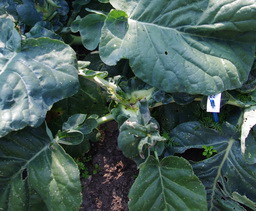 The hot dry weather is doing strange things all over the garden. My ability to provide survival irrigation is limited and we tend to favour the area that is mostly vegetables. I enjoy the flowers but we eat from that one garden so it gets what little water I can provide. While I’m writing this there is a soaker hose running in one of the front yard, flower beds and it curls under the Camperdown Elm that is also showing some stress signs. The cauliflower in the back has produced huge leaves but in the centre where we might expect to see some delicious white curd there is but a blind dead spot, proving once again that it really is a cool weather crop. I ripped them out this morning and planted some late season beans. I will also start some seeds of all of those cool season vegetables so that I will have transplants to put in the garden by mid August. Cauliflower, Broccoli and Pak Choi in early October will be a treat. Amazingly, both types of Cabbage have managed to head up nicely.
The hot dry weather is doing strange things all over the garden. My ability to provide survival irrigation is limited and we tend to favour the area that is mostly vegetables. I enjoy the flowers but we eat from that one garden so it gets what little water I can provide. While I’m writing this there is a soaker hose running in one of the front yard, flower beds and it curls under the Camperdown Elm that is also showing some stress signs. The cauliflower in the back has produced huge leaves but in the centre where we might expect to see some delicious white curd there is but a blind dead spot, proving once again that it really is a cool weather crop. I ripped them out this morning and planted some late season beans. I will also start some seeds of all of those cool season vegetables so that I will have transplants to put in the garden by mid August. Cauliflower, Broccoli and Pak Choi in early October will be a treat. Amazingly, both types of Cabbage have managed to head up nicely.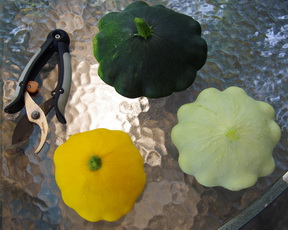 The heat lovers are growing well but struggling where I cannot get enough water to them. I have four very happy and healthy Patty Pan Squash plants that are providing us with more delicious summer squash than we can possibly eat. Just slice them in half and cover the cut surface with Curry Paste, or some similar flavour that you like, then put them on the grill for 8 - 10 minutes when they should be just softening up and absorbing the flavour of the sauce. Tomatoes and Peppers are looking great and starting to produce the first fruit. One batch of Tomatoes is wilting badly and last night’s water did not seem to help. I’m worried that some sort of fungal wilt disease has found them and if it has, will it spread to the others? At this point there is little or nothing that I can realistically do about it.
The heat lovers are growing well but struggling where I cannot get enough water to them. I have four very happy and healthy Patty Pan Squash plants that are providing us with more delicious summer squash than we can possibly eat. Just slice them in half and cover the cut surface with Curry Paste, or some similar flavour that you like, then put them on the grill for 8 - 10 minutes when they should be just softening up and absorbing the flavour of the sauce. Tomatoes and Peppers are looking great and starting to produce the first fruit. One batch of Tomatoes is wilting badly and last night’s water did not seem to help. I’m worried that some sort of fungal wilt disease has found them and if it has, will it spread to the others? At this point there is little or nothing that I can realistically do about it. 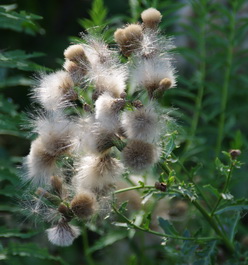 My inability to keep up with the weed growth has presented me with a dilemma. In the back corner of the yard there have been a nice? bunch of thistles growing. I have been even slower getting rid of these because it requires a trowel to get up the root and some gloves to keep them from attacking my hands. They are now filled with lovely soft thistle down which is just lots of seeds ready to wander around to other parts of the garden. Never when I have the camera handy, but at several other times I have watched a group of bright yellow finches enjoying these seeds. Thistle seed is apparently one of their treats. Do I leave these seeds and enjoy the finches or cut them down to prevent a much bigger crop from invading my garden next year?
My inability to keep up with the weed growth has presented me with a dilemma. In the back corner of the yard there have been a nice? bunch of thistles growing. I have been even slower getting rid of these because it requires a trowel to get up the root and some gloves to keep them from attacking my hands. They are now filled with lovely soft thistle down which is just lots of seeds ready to wander around to other parts of the garden. Never when I have the camera handy, but at several other times I have watched a group of bright yellow finches enjoying these seeds. Thistle seed is apparently one of their treats. Do I leave these seeds and enjoy the finches or cut them down to prevent a much bigger crop from invading my garden next year? 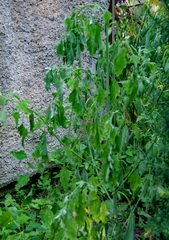 Even the severe drought can make this tired gardener smile. On the raised bed beside the garage I found this delight. A large native annual, usually considered a weed, lamb’s-quarters, Chenopodium sp. was in full wilt. When even the native weeds are wilting, it must be dry.
Even the severe drought can make this tired gardener smile. On the raised bed beside the garage I found this delight. A large native annual, usually considered a weed, lamb’s-quarters, Chenopodium sp. was in full wilt. When even the native weeds are wilting, it must be dry.Time to answer a few questions. If you have a gardening question just ‘reply’ to this newsletter and send me your query. I try to answer most of the questions and the ones that I answer here are those that I think will have the widest interest. You can also find the latest garden updates on the front page of gardening-enjoyed.com . |
| Back to Back Issues Page |
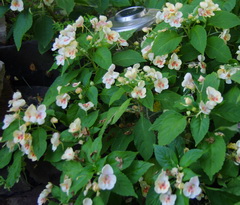 In an earlier issue, I mentioned
In an earlier issue, I mentioned